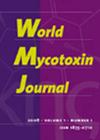Abiotic factors affect growth and aflatoxin B1 production by Aspergillus flavus strains on chilli powder and red chillies
IF 1.7
4区 医学
Q3 FOOD SCIENCE & TECHNOLOGY
引用次数: 2
Abstract
Chillies and chilli-based products are important spices on a global basis. The production, processing, transport and storage phases of chillies are prone to infection by Aspergillus Section Flavi and contamination with aflatoxins (AFs), especially aflatoxin B1 (AFB1) for which legislative limits exist in many countries. We have examined the effect of the interacting abiotic factors of water availability (water activity, aw; 0.995-0.850 aw) and temperature (15-37 °C) on (a) lag phases prior to growth, (b) growth, (c) AFB1 production and (d) contour maps of optimum and boundary conditions for colonisation and toxin production by three Aspergillus flavus strains on a 10% chilli-based medium. Additional studies with whole red chillies + A. flavus conidial inoculum on AFB1 contamination during storage for 10-20 days at 30 °C were also carried out. In vitro, the lag phases before growth were delayed by lower temperatures (15, 20 °C) and aw levels (0.928-0.901 aw). There was no statistical difference in growth between the three strains. Optimal growth was at 37 °C and 0.982 aw with no growth at 0.85 aw. Optimal temperature × aw conditions for AFB1 production were at 30 °C and 0.982 aw with no statistical difference in production between strains. No AFB1 was produced at 15-20 °C at 0.901 and 0.928 aw levels, respectively. In situ studies with A. flavus inoculated whole red chillies at 0.90 and 0.95 aw found that this species became the major component of the total fungal populations at 30 °C after 10-20 days storage. AFB1 contamination was above the European legislative limits (5 μg/kg) for spices at 0.90 aw after 20 days storage and at 0.95 aw after 10 and 20 days. This suggests that storage conditions of ≥0.90 aw, especially at ≥25-30 °C represents a significant risk of contamination with AFB1 at levels where rejection might occur, even after only 10-20 days storage.非生物因素影响黄曲霉菌株在辣椒粉和红辣椒上的生长和黄曲霉毒素B1的产生
辣椒和辣椒制品是全球重要的香料。辣椒的生产、加工、运输和储存阶段容易受到黄曲霉的感染,并受到黄曲霉毒素(AF)的污染,尤其是黄曲霉毒素B1(AFB1),许多国家对其存在立法限制。我们研究了水有效性(水活度,aw;0.995-0.850 aw)和温度(15-37°C)等相互作用的非生物因素对(a)生长前的滞后期、(b)生长、(C)AFB1产生和(d)三个黄曲霉菌株在10%辣椒基培养基上定殖和毒素产生的最佳和边界条件的等高线图的影响。此外,还对全红辣椒+黄曲霉分生孢子接种物在30°C下储存10-20天期间对AFB1污染的影响进行了额外研究。在体外,生长前的滞后期因较低的温度(15-20°C)和aw水平(0.928-0.901 aw)而延迟。三个菌株之间的生长没有统计学差异。最适生长温度为37°C和0.982 aw,0.85 aw时无生长。AFB1生产的最适温度×aw条件为30°C和0.9 82 aw。菌株之间的生产没有统计学差异。在15-20°C、0.901和0.928 aw水平下,分别未产生AFB1。黄曲霉在0.90和0.95 aw下接种全红辣椒的原位研究发现,在储存10-20天后,该物种在30°C下成为总真菌种群的主要组成部分。储存20天后0.90 aw和储存10和20天后0.95 aw时,香料的AFB1污染高于欧洲立法限值(5μg/kg)。这表明,≥0.90 aw的储存条件,尤其是在≥25-30°C的储存条件下,即使在储存10-20天后,也存在AFB1污染的显著风险。
本文章由计算机程序翻译,如有差异,请以英文原文为准。
求助全文
约1分钟内获得全文
求助全文
来源期刊

World Mycotoxin Journal
MYCOLOGY-
CiteScore
4.60
自引率
5.00%
发文量
25
审稿时长
>12 weeks
期刊介绍:
''World Mycotoxin Journal'' is a peer-reviewed scientific journal with only one specific area of focus: the promotion of the science of mycotoxins. The journal contains original research papers and critical reviews in all areas dealing with mycotoxins, together with opinions, a calendar of forthcoming mycotoxin-related events and book reviews. The journal takes a multidisciplinary approach, and it focuses on a broad spectrum of issues, including toxicology, risk assessment, worldwide occurrence, modelling and prediction of toxin formation, genomics, molecular biology for control of mycotoxigenic fungi, pre-and post-harvest prevention and control, sampling, analytical methodology and quality assurance, food technology, economics and regulatory issues. ''World Mycotoxin Journal'' is intended to serve the needs of researchers and professionals from the scientific community and industry, as well as of policy makers and regulators.
 求助内容:
求助内容: 应助结果提醒方式:
应助结果提醒方式:


